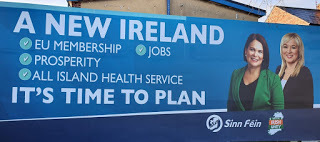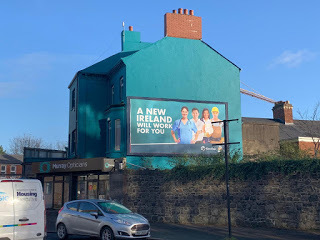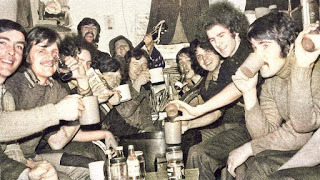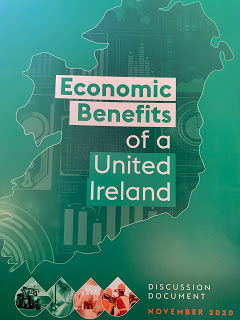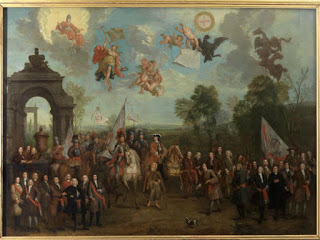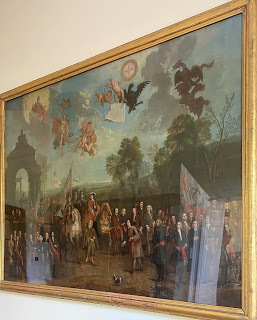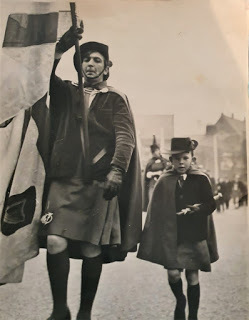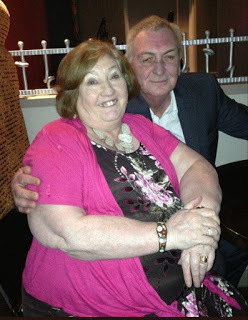Gerry Adams's Blog, page 23
January 18, 2021
Blog: Des Wilson, The Peoples Priest; How Mandela and his comrades paid tribute to hunger strikers; A week of high drama in Washington DC
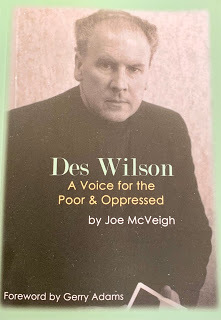
Des Wilson – A Voice for the Poor and Oppressed by Joe McVeigh
Fr. Joe McVeigh was a close friend and colleague of Des Wilson. It wasn’t just that both were priests. They both shared a passionate believe in justice and were committed to standing up for the rights of citizens against a British state apparatus which was oppressive and violent.
Fr. Des died on the 5th November 2019 aged 94. He lived a full life. A good life. And in the course of his years of service he helped thousands of people. During the dark years of war and violence he lived and worked in Ballymurphy and Springhill. With Joe McVeigh, Fr. Des established the Community for Social Justice. Its role was to highlight the real nature of violence in Ireland and to challenge the leaders of the Church. Fr. Des believed that the Church had a moral responsibility to stand against injustice and repression.
As a tribute to his friend Fr. Joe has just published a thoughtful pamphlet - Des Wilson – A Voice for the Poor and Oppressed by Joe McVeigh - telling the story of Des, his early life, his work as a priest in St. John’s parish and then in Ballymurphy and Springhill, and then setting up of Springhill Community House. Fr. Joe describes its purpose:
“ Des had a deep love and respect for the people in the Ballymurphy/Springhill community in which he lived. He always had time for a conversation and a cuppa tea. The door was always open. There was always a céad mile failte. Conversations at lunch in Springhill were a lively and interesting experience. Springhill Community House became ‘a house of hospitality’ somewhat like the Catholic Worker houses in America which had been set up by Dorothy Day and Peter Maurin in the 1940s and 1950s, and indeed somewhat like the Celtic monasteries in years gone by.”
Fr. Des was deeply affected by the killing of his colleague Father Hugh Mullan and ten local people by the British Army’s Parachute Regiment in August 1971 during internment. The Ballymurphy Massacre left families and a community devastated and Des was always there supporting their efforts for truth.
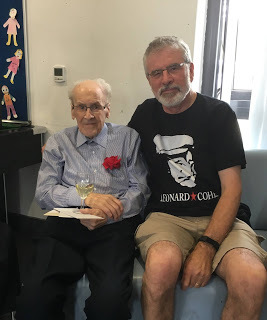 For over 40 years Fr. Des was at the heart of many of the positive initiatives to emerge from west Belfast, including Springhill Community Centre; Conway Mill and the peace process. He was a leader, a man of great courage and vision, a good neighbour, an honest down to earth decent human being and a priest.
For over 40 years Fr. Des was at the heart of many of the positive initiatives to emerge from west Belfast, including Springhill Community Centre; Conway Mill and the peace process. He was a leader, a man of great courage and vision, a good neighbour, an honest down to earth decent human being and a priest.
Joe McVeigh’s account of his life is evidence of a man who lived a long and full life and whose contribution to community politics, to education, and to peace in Ireland is immeasurable. I want to commend Fr. Joe for writing this account of Des’s life. If you are interested in buying a copy of Fr. Joe’s book - Des Wilson – A Voice for the Poor and Oppressed – it will be available from Springhill Community House and An Fhuiseog, 55 Falls Road when they reopen following the current lockdown priced £5.
The ANC and the 1981 hunger strikers
The African National Congress was founded on 8 January 1912. Last week, it celebrated its 109 birthday. An odd number you might think to celebrate a birthday. However, 30 years ago the ANC leadership was able for the first time in 30 years to publicly mark its 79th birthday following the unbanning of the party by the apartheid South African government.
In its online celebration last Friday the ANC broadcast the archive film footage of the historic press conference from 30 years ago - January 1991. The then ANC President Oliver Tambo – who had just returned home from 30 years of exile - Deputy President Nelson Mandela, who had been freed the year before after 27 years in prison; and Walter Sisulu who had spent 26 years imprisoned on Robben island, all spoke of their hopes for the future and their determination to achieve a free South Africa.
As I watched the five minute video of these three giants of the South African liberation struggle I was reminded of all that has happened in that country and of the four years of difficult and dangerous negotiations that lay ahead of them. An agreement was finally achieved and in 1994 Mandela was elected as President of a free South Africa. But as the three spoke in January 1991 the outcome of the negotiations was uncertain. The political and personal risks they were taking were enormous. Violence was still widespread. Thousands were still in prison. And there was significant opposition within the apartheid system to any negotiated settlement.
The year after the 1994 election I had the honour and pleasure to meet Nelson Mandela and Walter Sisulu. In June 1995 I travelled to South Africa as part of a Sinn Féin delegation to meet with the ANC’s senior negotiators. Our objective was to talk to them about their strategies and tactics and to see what Sinn Féin could learn from their experience for our peace efforts. The IRA cessation was then ten months old and the British were stalling on establishing all-party talks. By the end of our visit we had made many new friends, confounded the British who had tried to block a meeting with President Mandela, and were pleased to discover that our peace strategy was already following the pattern of that used by the ANC.
On our first day in the country we were taken to have lunch with the ANC’s National Executive at their party headquarters in J’Burg. To our great surprise and honour Walter Sisulu, the grand old man of African resistance who had retired from his ANC positions after the 1994 election (he was then aged 82) made a special point of coming to the lunch. The room was packed and all of us sat riveted to Walter Sisulu’s description of his 26 years in prison and his memory of the deep respect and solidarity ANC prisoners had for Bobby Sands and his nine comrades who died on hunger strike 40 years ago this year in the H-Blocks.
ANC prisoners had watched events unfold in our prison struggle. Sisulu recalled hearing of Bobby’s death and of the silent tribute ANC prisoners across South Africa paid to a fellow freedom fighter. Most of our delegation was in tears by the time he was finished. Speaking to him privately later Walter told us that ANC prisoners marked and commemorated each of the hunger strikers who died. Mandela too spoke of the hunger strikers when we met him. On the wall calendar in his cell on Robben island on the 5th May 1981 a simple single line is written: ‘IRA martyr Bobby Sands dies.’
Afterwards I presented Walter Sisulu with a wooden Celtic cross carved by the republican prisoners in Long Kesh. It was one of several gifts made by the prisoners that we had brought with us, some of which were damaged when the British opened our baggage in Heathrow airport. An ANC former prisoner helped repair them. Later another ANC activist who had spent 15 years on Robben island was to tell us that from that point on ANC prisoners rarely spoke of ‘a hunger strike.’ When discussing whether a hunger strike should be employed in any given situation the political prisoners referred toit as ‘a Bobby Sands’.
This year we in Ireland will mark 40 years from the 1981 hunger strike. It is important that like Nelson Mandela and Walter Sisulu we remember and honour those who courageously gave their lives for their comrades and whose extraordinary valour set an example for people in struggle around the world.
The storming of the Capitol
The political and constitutional fallout in the USA to the unparalleled events last week in Washington will continue for years to come. I have visited the Capitol Building many times since my first visit to Washington DC in September 1994. I know well many of those Congressional and Senate representatives and their staffers who have regularly met with me to discuss Ireland. It was surreal and deeply troubling to watch as mobs rampaged along corridors and stairwells and offices that I have visited many times. Consequently, my thoughts last Wednesday, as I watched the disturbing scenes in the Capitol Building unfold, were primarily for the women and men who work there and who have worked closely with us in promoting peace and unity.
In recent decades Sinn Féin has developed a strong connection with those on Capitol Hill who are Democrats or Republicans or neither. Sinn Féin does not involve itself in the internal affairs of the USA. It’s not our business. But we long ago understood the importance of encouraging successive US administrations to have a progressive foreign policy position on Ireland. We have worked closely with Irish America to make that happen.
That approach has worked well both in terms of US support for the peace process; opposition to any efforts to dilute or undermine the Good Friday Agreement – especially as a consequence of Brexit - and endorsement of the goal of Irish Unity.
I want to extend best wishes to all our friends on Capitol Hill. I would also like to thank some of those Congressional members who will no longer be on the Hill and who were steadfast in their support for the peace process. Eliot Engel, Peter King and Joe Kennedy are moving on. Thank you for your solidarity.
Finally, comhgairdheas to Boston Mayor Marty Walsh who has been appointed to President Biden’s cabinet as Secretary of Labor. Secretary Walsh is a son of Irish immigrants from Connemara and has worked closely with Máirtín O’Muilleoir and John Finucane MP in recent years in building up a close relationship between Belfast and Boston. In a video message in November to the opening ceremony of the 2020 Golden Bridges Conference linking Northwest Ireland and Irish America,Marty Walsh said: “Under the leadership of President-elect Biden, the United States is ready to move forward and to once again live up to our highest ideals. And we are committed to supporting peace and unity in Ireland, too."
I have every confidence that the Biden administration and the new Congress and Senate will build on the positive work of recent years. I look forward to an even closer relationship in the time ahead.
January 11, 2021
This weeks Blog: Stay Safe; Brexit Border; Irish govt & UN Security Council; & Solidarity with Catalonia
Stay Safe.
As the pandemic surges out of control the under investment in health services north and south on this island is obvious for everyone to see. The good news of the vaccine must be tempered with a resolve by all of us to follow the health advice and to minimise contact with others until the vaccine is administered. When we eventually put this horrible pandemic behind us we must also be resolved to ensure that a fully resourced and accessible public health service becomes a reality.
The Brexit Border
An hour before midnight on New Year’s Eve the Brexit deal was finally done – sort of. Four and a half years after the Brexit referendum the little Englanders and the DUP party who campaigned for Brexit got their way. The British state left the EU, including the people of the North and of Scotland who voted to remain.
Of course, it didn’t quite work out the way the DUP wanted. Instead of a ‘United Kingdom’ waving goodbye to Europe they now have a deeply disunited kingdom with Scotland battering at the gates of independence; Welsh nationalism on the rise; and the demand for a referendum on Irish Unity a growing demand across Ireland.
In addition the North remains in the EU’s single market for goods and will apply EU customs rules at its ports under the watchful eye of EU officials. There are now export checks and regulatory differences between the North and Britain. Full responsibility for this rests squarely with the DUP.
It will take a while for the dust to settle on the mess that has been created by Brexit but a mess it is. Ireland’s interests north or south were never a consideration in the English, or the DUP support for, the decision to leave the EU. Indeed, Ireland only became an issue in the Brexit negotiations when Sinn Fein ensured that the issue of the Good Friday Agreement, and avoiding a hard border, would be a central objective of the EU negotiators. However, there is a way out of the chaos that will unfold in 2021. It is rooted in the Good Friday Agreement – the people of the north have the right to choose which union we want to be a part of: a new union between all the people of the island of Ireland or the old failed unacceptable and imposed union with England.
One thing is certain. There will be a referendum on Irish unity. There are no ifs about it, though resistance from the usual suspects, to a referendum will continue. It is now a matter of when that referendum will be held. So those of us who want self government need to increase our efforts, and intensify the sensible call for the Irish government to initiate ways to plan how we will agree our future. Better still we need to start planning that future now.
The Irish government and the UN Security Council
As 2020 came to a close most of the public and media focus was understandably on the outcome of the Brexit negotiations and the increase in the number of people across the island of Ireland testing positive for the Coronavirus.
However one other event also deserves attention. As of 1st January the Irish government holds one of 15 seats on the UN Security Council. In June of last year a secret ballot among the almost 200 member states saw the Norwegian and Irish governments win two non-permanent seats on the Council. They will hold these influential seats for the next two years.
The Irish government campaigned for the seats on the basis that it will defend and promote human rights and peace. Its success in winning the Security Council seat provides a unique opportunity to make a positive impact in world affairs, international relations and in peoples’ lives. There are a significant number of armed conflicts and international disputes which urgently need a positive engagement by the UN, including in the Middle East. The plight of the people of Palestine is crying out for justice.
Poverty, hunger, and water scarcity is also on the increase. Almost one billion people do not have access to clean water and climate change is set to make this dire situation worse.The government also has a responsibility to use this unique opportunity to defend the Good Friday Agreement – which is an international Treaty lodged with the UN – to defend the peace process and to use this crucial international forum to insist that the British government honour its GFA commitments on human rights, legacy matters, and the role of civic society which it has so far refused to implement.
Most importantly, in a forum which places great emphasis on self-determination and self-government (the UN has grown from to 51 states in 1945 to 193 today) there is an onus on the Irish government to use this forum to articulate the desire for a United Ireland. As the debate for the referendum on Unity continues to grow the government now has within its grasp at the United Nations an unparalleled opportunity to further that objective, democratically, peacefully, and inclusively.
Solidarity with Catalonia
Like many other republicans I have spent several Christmas’s in prison. It’s not a nice place to be at any time but especially over Christmas. I was reminded of this a few days before Christmas when I had the opportunity to hold a video conference with two of the imprisoned leaders of 'Esquerra Republicana de Catalunya' (ERC) - the main pro-independence party in Catalan.
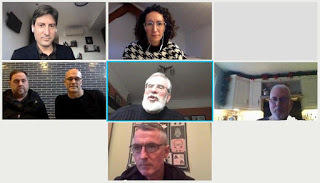 Oriol Junqueras is President of the ERC and Raul Romeva is the former Foreign Minister of the Catalan government. Both are currently serving prison sentences of 13 years and 12 years respectively in Lledoners prison, Catalonia. Declan Kearney MLA joined me in the conversation and also in attendance was Marta Rovira, the ERC’s General Secretary, who is currently exiled in Switzerland, and Jordi Solé, the ERC's Secretary for International Affairs.
Oriol Junqueras is President of the ERC and Raul Romeva is the former Foreign Minister of the Catalan government. Both are currently serving prison sentences of 13 years and 12 years respectively in Lledoners prison, Catalonia. Declan Kearney MLA joined me in the conversation and also in attendance was Marta Rovira, the ERC’s General Secretary, who is currently exiled in Switzerland, and Jordi Solé, the ERC's Secretary for International Affairs.
The imprisonment of the two comrades arose from the peaceful and democratic independence referendum that was held by the government of Catalan in October 2017. The Spanish state reacted violently. Our television screens were filled with images of Spanish Civil Guards firing plastic bullets at Catalan citizens trying to vote, and violent scenes of heavily armoured police batoning defenceless and peaceful citizens – some of them lying on the ground, many of them women, some elderly.
The 2017 referendum was the culmination of almost two decades of Catalan efforts to achieve greater autonomy within Spain. Catalan leaders tried to engage successive Spanish governments in a dialogue but their efforts were rebuffed. They were frustrated at every turn by an intransigent central government and the courts.
Rather than engage in a process of dialogue to resolve this constitutional crisis the Spanish government choose to arrest and imprison senior Catalan politicians. Oriol Junqueras and Raul Romeva are among those who received lengthy prison sentences. Despite their unjust treatment and imprisonment both men were in good spirits when we spoke to them and clearly determined to continue their struggle for freedom and independence.
Our conversation lasted an hour. Declan and I expressed Sinn Féin's ongoing solidarity with all of the political prisoners, those leadership figures still in exile, and the right of the Catalan people to independence. We also expressed our support for the Amnesty Bill currently being proposed by Catalan Independent representatives.
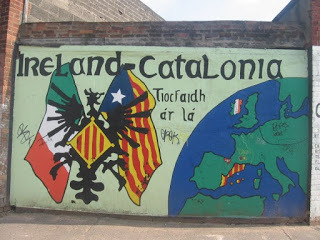 The connections between the people of Ireland and of Catalonia go back a long way. In 1920 Máire Ní Bhrian, a member of Cumann na mBan, travelled to Catalonia as part of the republican outreach seeking support for the Irish cause in Europe. Writing after the death on hunger strike of Terence MacSwiney the Lord Mayor of Cork, Ní Bhrian recalled;
The connections between the people of Ireland and of Catalonia go back a long way. In 1920 Máire Ní Bhrian, a member of Cumann na mBan, travelled to Catalonia as part of the republican outreach seeking support for the Irish cause in Europe. Writing after the death on hunger strike of Terence MacSwiney the Lord Mayor of Cork, Ní Bhrian recalled;
‘In Barcelona and in Catalonia generally there was the deepest sympathy for Ireland and when Terence died the papers there were full of articles about him and masses were offered for him in many churches which were crowded to the doo… The Catalans always cherish the desire for separation from Spain and their aspiration for independence is the bond between them and us.’
A doll dressed in traditional Catalan clothing was sent from the people of Catalonia to MacSwiney’s young daughter Máire. Last year the doll was refurbished as part of an exhibition on MacSwiney by Cork public museum.
The Spanish government needs to return to the negotiating table. The international community, especially the European Union, has an obligation to ensure that Catalonia can pursue the course of self-determination without fear of suppression.
In the meantime find below the names and addresses of imprisoned Catalan leaders and political prisoners. Take a few minutes and send them a solidarity card – a letter – a book. Show them they are not alone and not forgotten.
Dolors Bassa Coll
Centre penitenciari Puig de les Basses
Mòdul de dones
Raval disseminat, 53
17600 Figueres
(Girona)
Jordi Cuixart i Navarro
Centre Penitenciari de Lledoners
Mòdul 2
Carretera C-55, km 37
08250 St Joan de Vilatorrada
(Barcelona)
Carme Forcadell Lluís
Carme Forcadell i Lluís
Centre Penitenciari Wad Ras
Doctor Trueta, 76
08005 Barcelona
Joaquim Forn i Chiarello
Centre Penitenciari de Lledoners
Mòdul 2
Carretera C-55, km 37
08250 St Joan de Vilatorrada
(Barcelona)
Oriol Junqueras i Vies
Centre Penitenciari de Lledoners
Mòdul 2
Carretera C-55, km 37
08250 St Joan de Vilatorrada
(Barcelona)
Raül Romeva Rueda
Centre Penitenciari de Lledoners
Mòdul 2
Carretera C-55, km 37
08250 St Joan de Vilatorrada
(Barcelona)
Josep Rull i Andreu
Centre Penitenciari de Lledoners
Mòdul 2
Carretera C-55, km 37
08250 St Joan de Vilatorrada
(Barcelona)
Jordi Sànchez i Picanyol
Centre Penitenciari de Lledoners
Mòdul 2
Carretera C-55, km 37
08250 St Joan de Vilatorrada
(Barcelona)
Jordi Turull Negre
Centre Penitenciari de Lledoners
Mòdul 2
Carretera C-55, km 37
08250 St Joan de Vilatorrada
(Barcelona)
January 4, 2021
Bliain Úr Faoi Mhaise Daoibhse.
Bliain Úr Faoi Mhaise Daoibhse.
Chairde, a very happy 2021 to you all. Here are ten personal things I want to do in this bright new year.
· Survive the pandemic. Stay alive and stay healthy. That means following the health advice and getting the vaccine as soon as I can.
· Climb Errigal again. I used to do that regularly but the pandemic and travel restrictions intruded. Ewan McColl wrote ‘The Joy Of Living’, a very fine song when he realised that he could not hill walk or climb as he used to because of his age. I never really knew what he meant until my last ascent up Errigal. But as I panted slowly heavenwards I discovered the secret. Take your time. It’s not a race. So I will keep going upwards for as long and as slowly as I can. And as soon as possible in 2021.
· Publish my new book of short stories. The Witness Tree has also fallen foul of the pandemic but hopefully mid summer will see O’Brien Press launching this collection.
· Keep producing the Léargas series, in partnership with the incredible R G McAuley. This not for profit project is aboutwomen and men I came to know, or know of, alonglifesjourney. Kathleen Thompson, nee Largey,nee McCready, the singer and activist, is the subject of our next tribute. Hopefully to be published before Easter. Then we intend to do one about The Armagh Women in time for the Hungerstrike Anniversary.
· Get to more games. The standard of hurling, camogie and football at underage, and all other levels, is rising in Belfast as a result of the work of many dedicated local GAA volunteers, parents and mentors and club stalwarts. Spectating is a great way to support Gaelic games. Commenting on the state of play and shouting loudly about the referee’s shortcomings from the safety of the ditch, is a great way to entertain those around you. And to get rid of stress. And self-respect.
· Learn an entire song. It is a little known fact that I gave up a promising singing career in order to concentrate on the cause of Irish freedom. I have recently realised that I know a few lines of hundreds of songs but if I was called on to sing I could not sing an entire song. I hope to rectify that by learning all the words of I Wish I Had Someone To Love Me and Mo Ghille Mear.
· Get called to sing.
· Improve my knowledge and use of the Irish language.
· Give up Twitter.
· Have a few very pleasant ordinary social outings with family and/or friends.
· Intensify my involvement in the cause of Irish freedom so that I can enjoy being a citizen in a free Ireland as soon as possible.
· Relaunch my singing career.
A DOGS LIFE!
We have two dogs. Truth to tell we have had two dogs for a very long time. Once we had three. Three times or four times when puppies arrived we had a dozen or so. But that was only for a wee while. I wouldnt be without a dog. Since I was about six or so, when my uncle went to Canada and left his dog with me, there has always been a mutt in my life.
Our two dogs are Fionn and Fiadh. They are labadors, a good breed, especially tolerant of children. Fionn is a large male, beautifully gingerishly gold in colour and very handsome. The problem is he won’t let another dog pass him without challenging it to a fair dig. He is also very strong and hard to contain when he engages in this belligerent behaviour. Apart from the stress and sheer annoyance involved I am very embarrassed by these outbursts. As a dog owner of the old school I believe that the human must always be in control of the canine. I tut tut to myself when other dogs ignore the commands of their humans. So when my dog does that to me I am scundered.
Incidentally Fionn’s belligerent behaviour can be traced to a mauling he endured when he was a pup. A particularly obnoxious terrier seized him one day in the Falls Park and left him bloodied and wounded and in need of medical attention. This trauma is at the root of Fionn’s anti social attitude to other dogs. This tendency increased when Fiadh arrived. Fiadh is from Tipperary. She is a smaller, more intelligent and a much more biddable hound. With a very fetching smile. She is also a bitch. She made Fionn a father. Twice. That added a jealous macho element to his behaviour around other dogs, especially if he is in Fiadh’s company.
Controlling him on his own in these circumstances is challenging. Controlling the two of them is a herucüalean task. It takes the joy out of a good walk. Unless in a lonely wild place which is devoid of other mutts. And that’s not always easy to get to. Especially with big dogs. Transporting them can be problematic.
Why am I telling you all this? I suppose I have to tell someone. I am coming slowly to terms with the reality that big dogs and I have had our day. I think I have a way forward. I could leave the dog walking to more enabled,younger,anonymous family members. And I could get a smaller dog for myself. A wee Cairn terrier, a Glen of Imaal madadh, or a good old fashioned mongrel? A wee house dog. That would be the solution. If my good wife and Fionn would let him or her in. That seems unlikely at the moment but I think it is the only feasible solution.In the longer term.So I intend to work on that. Slowly.
In the meantime I won't give up entirely on walking Fiadh or Fionn. Dogs love walks. Even more than they like their dinner. And I’m contrary. So if you spot me being dragged by two, or even one, large good looking canine, along the highways and byways of West Belfast be warned. Especially if you are walking your dog. Take pity on me. As much as I hate to admit it I’m not entirely in control. It’s hard to teach an old dog new tricks. Stay clear. And don’t blame me. Big dogs make me do it.
FINALLY.
While Brexit and the Coronavirus dominated the political agenda for much of 2020 nonetheless the debate on the proposal in the Good Friday Agreement for a unity referendum and the value, form and nature of such a referendum, have all gathered momentum. Several initiatives on this by academics have recently taken place; two weeks ago Fianna Fáil MEP Billy Kelleher held an interesting and informative online debate on this issue; and Sinn Féin, Ireland’s Future and others have also held similar online events.
The constitutional status of the North has long been the determining factor in northern politics. I believe the opportunity now exists for this generation to finally end this by achieving a United Ireland.
From an Irish republican perspective 2020 was a good year. It saw the restoration of the power sharing institutions of the Good Friday Agreement, the continuing electoral erosion of political unionism, and the emergence of Sinn Féin as the largest party in the 26 counties. Sinn Féin is now the largest party on the island of Ireland.
A continuation of the hard work that achieved these gains means that the opportunities in 2021 for continued growth and for the advancement of Irish Unity are enormous. The positive arguments in favour of self-government and for Irish Unity are common sense and winning more and more converts. So, if you believe in a new Ireland – a shared Ireland – based on fairness, equality and mutual respect join the conversation in 2021 for a United Ireland.
December 28, 2020
Nollag Shona Daoibhse. A Visit to Bethlehem
Nollag Shona Daoibhse.
This Christmas will be unlike any other Christmas for most of us. The pandemic is to blame for that. Christmas can be a lonely place for some people. This year will be especially lonely for families who lost loved ones to the Coronavirus. Our thoughts are with them all. I hope everyone who can, enjoys the festive season as best as you can. Nollag shona daoibhse.
There are lots of things to dislike about the modern Christmas. The blatant commercialism of it. That may be a recent trait. Or maybe it was always thus. But nowadays the omnipresent pervasive media, social and otherwise, makes it difficult to escape the relentless advertising of the latest fad that we are persuaded that our children, spouse or friends cannot do without. I hate - if that’s not too strong a word - the distress caused for so many who cannot afford it getting caught up in this madness and getting into debt as a result. My heart goes out to stressed-out parents trying to make ends meet. I also greatly resent ‘Xmas’ replacing ‘Christmas’.
You dear reader may respond to these remarks by declaring; ‘That’s not Christmas’. You may characterise my comments as Scrooge-like. You may even mutter; ‘He has turned into The Grinch’. All this may or may not be true. But it misses the point. The point is Christmas is supposed to be about the birth of a little baby. Some believe this baby was the son of God, sent to save humanity. If he was it is edifying that he was born in a stable, in poverty, the boy child of a refugee couple, Joseph and Mary, fleeing from occupation forces.
If God was trying to teach us a lesson there is a lifetime of lessons in that. Jesus wasn’t born in a palace. Or a grand big mansion. He was not born in a castle surrounded by riches and wealth. The baby Jesus was surrounded by farm animals. The stable was a cave. His bed was a manger. He grew up to become a working man, like Joseph the carpenter. His daddy. He grew up to teach love and fairness. His teachings are generally non-judgemental. Except when he addressed the great and the good. The wealthy powerful one. In the end he was executed, done to death by crucifixion, by the great and the good. The wealthy powerful ones.
I greatly appreciate those who work over Christmas. In hospitals and hospices. Nursing homes and orphanages. On the streets with the homeless and helpless. The Emergency Services. The ones who mind us.
So it is good that we, believers or sceptics, should celebrate Christmas. And all humanity’s other great feast days. And that we should celebrate our own joyousness and good heartedness. Whether Christian or Jew, Muslim, Buddist or Pagan. Believer or Non Believer. We should celebrate and give thanks for the great benevolent givingness of decent hopeful people.
I have lost most of my faith in the institutional Christian church. I know great churchmen and women who I respect. I still like Mass, the sociability and assurances of it. But any institution which refuses to accord women full rights or which is more concerned about controlling instead of empowering, or with rules and obscure doctrinal matters has lost its way. Institutions tend to do that unless they are democratic and empowering. They forget their founding purpose. Or origins. In this case a baby born in a stable who grew up to mix with all the ‘wrong’ people.
I like the crib. The baby Jesus. I remember there was a stuffed camel in the crib in Clonard. It was a childish treat to visit it. Or the Moving Crib in Parnell Square in Dublin. The simplicity of it. That’s the Christmas I like. I like Dadaí na Nhollag. Daddy Christmas.
I like giving and receiving presents. There is nothing I need but I like not to be forgotten. I try not to open my presents until Christmas Day.
I love that children are at the centre of it all. I like nice surprises. I love mince pies and good Christmas pudding. I love my Christmas dinner, especially when others cook and serve it and you get a wee drink as well.
And pre-pandemic and post-pandemic when extended family and friends break bread together. When we give silent thanks for the roof over our heads and the warm fire and family and friendship, the good food and company.
And think fondly of absent friends. And others not as well off as we are. Lonely, impoverished isolated pilgrims. In this time of pandemic Christmas will be a strange occasion for many people.
I dislike Boxing Day. I’m a Saint Stephen’s Day man. A day for the outdoors, for walks and Christmas Day left overs and lazing about. An old crocks match. And a decent film. Or a good book. Another wee drink or two. Peace and quiet. Celebrating life and the goodness of it.
So Christmas is about us minding each other. Trying to be kind. Making the effort. Like the Inn keeper who relented and gave Joseph and the very pregnant Mary shelter from the cold.
Happy Christmas to you all. That’s the preaching over for this year. Mind yourselves. Be kind. And tolerant. And thankful. Nollag shona daoibh.
A Visit to Bethlehem.
In December 2009 I visited Bethlehem as part of a week-long visit to Israel and Palestine for a documentary on Jesus. It was one episode of a Channel 4 series, The Bible: A History. My role in the episode was to discover the real Jesus – Jesus the man; the historical Jesus. We know only about one year of his life. Was it possible to look at what came before this? What type of person was he? Did he have siblings? Sisters? Brothers? Girl friends? Children? I was very taken by this challenge. I was intrigued by the opportunity to visit what many call ‘The Holy Land’ to reflect on the life of this singular figure.
As a strong supporter of the people of Palestine I also wanted to set this unusual opportunity in the context of today’s Israel and Palestine. I had visited the Palestinian territories before. Eight months earlier in April 2009 a delegation of us were there. At that time we met a huge number of NGOs, Israeli and Palestinian human rights organisations, women's groups, refugees, community organisations, all of the main Palestinian political parties and a Kadima member of the Israeli Parliament. We visited Ramallah and Bethlehem and spent two days in the Gaza Strip.
In December 2009 my visit was non-political. It was the run in to Christmas Day. Bethlehem was aglow with Christmas lights and colourful Christmas trees were evident everywhere. There were crowds of tourists visiting the Church of the Nativity. It is a World Heritage site and holds the grotto which is believed to be the birthplace of Jesus.
But Bethlehem is also an occupied city. The tragic irony of this was sharpened for me by my new and growing knowledge of the ancient history of the place gleaned from the conversations I was having about Jesus and the Palestine of 2000 years ago. At that time Bethlehem was an occupied town under Roman rule. Roman soldiers patrolled its streets and Roman policies dictated the economic and much of the social life of the region. Most importantly the Jewish people were denied their freedom – a denial which led to several failed and bloody rebellions.
In 2009 and still today the people of Bethlehem live under Israeli military occupation. The Israeli separation wall – a monstrous construction which stretches for hundreds of kilometres – and separates Palestinian families; separates farmers from their farming land and their water – overshadows Bethlehem. It surrounds the town. The Wall, the military fences and gates through which Palestinian workers must go each day to and from work and the armed Israeli soldiers are a constant reminder of military occupation. So too are the frequent reports of Israeli brutality, house demolition and killings.
Christmas is a time is for everyone and especially children, but if you are a Palestinian child living under Israeli military occupation then you face constant threat and danger. A report last week from ‘Defense for Children International – Palestine’ (DCIP) entitled - “Isolated and Alone: Palestinian children held in solitary confinement by Israeli authorities for interrogation” – reveals the detail of arrests, the conditions of detention, and interrogation practices against children by Israeli authorities. The report concludes that the Israeli practices amount to torture or cruel, inhuman, or degrading treatment under international law norms. If you would like to read it google: https://www.dci-palestine.org/israels_isolation_of_palestinian_child_prisoners_amounts_to_torture
The report documents 108 cases in which Palestinian children arrested by the Israeli military were held in isolation for two or more days. The average duration of isolation was 14.3 days and 43 of the children endured a prolonged period of isolation of 16 or more days. The report states that, “The interrogation techniques used by Israeli forces are mentally and physically coercive...They combine intimidation, threats, verbal abuse and physical violence with the clear intention of obtaining a confession.”
I have now visited Israel and Palestine four times. I always leave feeling deeply saddened at the plight of the Palestinian people and the failure of the international community to do what it should to encourage a peace settlement.
2020 has been especially difficult for the Palestinian people. The Coronavirus has made life much more difficult. Bethlehem is devoid of tourists. The hotels and the tourist shops are closed. 2021 is just days away. I wish the people of Palestine and of Israel a peaceful Christmas and I want to extend solidarity to the Palestinian people and to assure than that the people of Ireland continue to support their just demands for national sovereignty and independence.
December 22, 2020
DUP betrayed again by a British government and the British threaten the EU with gunboats
Betrayed again!
British policy is dictated by British interests. It has always been so. The fact that Prime Minister Boris Johnson has again betrayed unionists over Brexit should have come as no surprise to anyone with even the most rudimentary understanding of how British policy works. The British Prime Minister Palmerston spelt it out most clearly almost 200 years ago when he said: “We (England) have no eternal allies, and we have no perpetual enemies. Our interests are eternal and perpetual, and those interests it is our duty to follow...” Irish Republicans and others who have had first-hand experience of British duplicity have a name for it – perfidious albion.
The surprise is that so many unionists are surprised by the turn of recent events. Have they no memory of the twists and turns of Theresa May in her relationship with the DUP? Do they not recall the many warnings given, including by this writer that the deal reached between the DUP and Theresa May in the summer of 2017 would end in tears? The DUP thought they had it made. They believed that the confidence and supply arrangement which would see them keep May in power would ensure them enhanced influence at the heart of Westminster.
Less than a year later it was starting to fall apart. As the British negotiated the Withdrawal Agreement in October 2018 Arlene Foster warned: “There cannot be a border down the Irish Sea, a differential between Northern Ireland and the rest of the UK. The red line is blood red.”
With the British and the EU close to a Withdrawal Agreement Theresa May employed the bureaucratic gobbledegook language of the Sir Humphrey Appelby character in Yes Minister and wrote to Arlene Foster talking about “specific alignment solutions in some scenarios.” Arlene Foster interpreted this as preparedness on the part of the British government to embrace “the idea of a border down the Irish Sea.” Foster wrote a letter back to Theresa May in which she said that “The Prime Minister’s letter “raises alarm bells for those who value the integrity of our precious union.”
When the announcement of the Withdrawal Agreement was made some days later Sammy Wilson went into verbal overdrive. He described it as “a punishment beating for the UK because they dared to vote to leave the EU.”
The DUP stopped voting with May. It even voted with Labour. The DUP turned its back on May and embraced Boris Johnson as the saviour of the union. Two months after Foster’s “blood red” comments Boris Johnson was given a rousing welcome at the DUP party conference in Belfast. He warned against the North being left behind as “an economic semi-colony of the EU”; attacked any suggestion of regulatory or customs checks between the North and Britain describing them as; “damaging the fabric of the Union”; called on the British government to “junk the backstop”; and in a bizarre reference to the Titanic warned against the EU being allowed to set the rules for the North. Johnson said: “The Titanic springs to mind and now is the time to point out the iceberg ahead.”
Two years later and the Johnson government has driven the ship right smack into the iceberg and the DUP is facing mounting criticism as more and more people come to realise the failure of its strategy and the disastrous impact Brexit is going to have on the North’s economy and their lives. Under Johnson’s leadership all of the commitments he gave two years ago to the DUP have been abandoned. Worse, from their perspective, there will be a border down the Irish Sea; customs posts will exist in northern ports and airports checking goods coming from Britain; and the North will remain within the EU single market.
One consequence of all of this is that the words “betrayed” and “betrayal” have again been dusted off by political commentators and unionist politicians. The former UUP press officer and commentator Alex Kane was scathing of Boris Johnson last week. He wrote that the “sheer scale of this betrayal is unprecedented”.
The trouble is it’s not. In March 1972 the British government scrapped the Unionist regime at Stormont. In November 1985 they signed the Anglo Irish Agreement with Dublin. Hundreds of thousands marched in protest. Remember, ‘Never, Never Never!’ In December 1993 John Major signed the Downing Street Declaration with Albert Reynolds. In September 1997 the DUP walked away from the talks process because Sinn Fein joined it and stayed outside the process until 2007.
But then unionist political leaders since the Home Rule Bills of the 19thcentury, and especially the DUP in the last 50 years, have frequently relied on claims that unionists are being sold out or betrayed to mobilise support in opposition to any meaningful reforms. This tactic facilitated the creation of paramilitary groups like the UDA, UVF and Ulster Resistance.
Last week the Belfast Newsletter wrote in an editorial: “The Prime Minister will always do what is right for him personally, then for his party, and then for England.” That same comment is true for every British Prime Minister.
Remember the old adage? ‘Fool me once shame on you – fool me twice shame on me’. How should it go if you have been fooled so often and so shamelessly over so many decades? DUP-ed again?
So, if you are a unionist and are fed up with British politicians and unionist politicians, playing you for a fool, and betraying and using you in their own interests, consider a different future – a different approach. Consider engaging in the growing conversation about a new Ireland – a shared Ireland – in which new constitutional arrangements will protect and promote your interests. Remember, for Boris Johnson and others like him there is no precious union there is just eternal and perpetual English interests.
Gunboat diplomacy
Brexit is the outworking of a little Englander mentality that harks back to the days of Empire. It believes that by cutting itself off from its ties with the European Union a ‘sovereign’ Britain can attain the power and prestige it once enjoyed as the Empire on which ‘the sun never sets’.
A key tactic of British imperial strategy for much of the eighteenth and nineteenth centuries, and part of the 20th century, was the use of gunboat diplomacy. This was used when the British Empire wished to extend its economic and political influence and power, or curb the desire for independence by others, without the necessity of a full scale military intervention. British gunboats would be sent in to blockade ports and threaten governments. It was the brazen use of intimidation and the threat of greater violence to achieve its objective.
Of course the British were not alone in using this tactic. All of the European colonial powers used similar tactics. However, as the largest Empire ever in the history of humanity, and with a navy providing it with unrivaled power, the use of gunboat diplomacy allowed the British to hold hundreds of millions of people across the world in thrall to its demands and exploitation.
Last week gunboat diplomacy was resurrected by the British government. The weekend headlines in the British tabloids spelt it out “We’ll send in gunboats.” Four military vessels are on standby to take to the seas around Britain to defend its fish. One headline spoke of “Royal Marines abseiling from helicopters on to French vessels” and “arrest fishermen.”
Will the EU or indeed any of its member states feel moved to change their stance by a threat to use gunboats? Unlikely. What this does signify is that the narrow minded little Englander mentality that narrowly won the Brexit referendum in 2016 continues to be a potent force within the British political system. A further reason for Scotland and Wales to increase their efforts to achieve independence and a potent reminder to United Irelanders of the importance of achieving the unity referendum contained in the Good Friday Agreement and of winning that referendum.
Hail The Antrim Hurlers.
Well done Antrim. Well done the legions of hurling enthusiasts who kept the faith in lean times and passed on the skills and love for hurling to new generations. Well done Darren Gleeson and the management and backroom team. Well done all their predecessors and our county board. But especially well done to our warriors who battled tenaciously against a stubborn Kerry side; who never gave up until the ref finally brought Sunday’s game to a close and with it an All Ireland win for our glorious county. Aontroim Abú. Thank you Antrim Hurling Champions. Fáilte abhaile Joe Mac Donagh.
December 14, 2020
Blog: Are you listening to our voices, Micheál: Brexit mess intensifies unity conversation; and Billboards for Unity
Are you listening to our voices, Micheál?
Micheál Martin’s ‘Shared Island Unit’ is perceived by some as a positive initiative encouraging debate on Irish Unity, even though he fails to even mention unity in any of his utterances. For others it is a distraction. A talking shop that is short on strategy and lacking in vision. A means of pretending to be doing something while in fact doing as little as possible. And a way of avoiding taking the big steps necessary to plan for a referendum on Unity, or mapping out what the shape of that new Ireland will be if the referendum succeeds.
My own view is that United Irelanders should engage positively with An Taoiseach’ s Shared Island Unit but in full knowledge that it falls very far short of what Micheál Martin should be doing as part of his constitutional obligations and the imperatives of the Good Friday Agreement. In fact An Taoiseach is wilfully involved in the politics of illusion. But that should not come as a surprise to observers of his politics.
Despite Martin’s reluctance to be a persuader for Unity or to plan for a unity referendum the debate around Irish Unity has been intensifying. In recent weeks several important papers have been published by influential academic institutions and by Ireland’s Future. All of them highlight the need to plan for a referendum and to plan for Unity and that this needs to commence now.
The Ulster University published ‘Deliberating Constitutional Futures’ which examines the arguments around possible constitutional futures, including a unity referendum. Two weeks ago The Constitution Unit of University College London published an interim report from its ‘Working Group on Unification Referendums on the Island of Ireland.’
The report addresses the issue of what will constitute a winning vote. It states that the threshold for “the unification referendum in the North is ‘a majority of the people of Northern Ireland voting in a poll’. It would breach the Agreement to require a higher threshold than 50% + 1. In the South, approval of constitutional referendums likewise requires a simple majority.”
Critically the report authors highlight the danger of any failure to plan for a unity referendum. They state: “The years of acrimony following the UK’s vote on EU membership in 2016 illustrate the dangers of a vote called without adequate planning.” As part of this process of pre-planning the report calls for Citizens’ Assemblies to be established to help identify peoples’ views on what choices should be on offer in any referendum.
It adds: “All these criteria point towards the importance of advance planning: of the referendum processes; and about the shape of a united Ireland, or a continued Union.”
Is Micheál Martin listening? This conclusion is in direct contradiction to his refusal to plan for the time ahead.
Last week Ireland’s Future – an influential group of civic nationalists –published a discussion document entitled: ‘The Conversation on Ireland’s Future. A Principled Framework for Change.’ The paper deals with a series of key questions regarding the unity referendum process and as part of its launch Martina Devlin interviewed Professor Colin Harvey of Queens University. The interview is hugely informative and is still available on https://twitter.com/IrelandsFuture.
And like the report from the Constitution Unit the Ireland’s Future group “place emphasis on advance planning and the need for an evidence-based and informed debate. That is why we have suggested an all-island Citizens’ Assembly to underline the centrality of civic leadership in preparing the ground for change.”
So, planning for a unity referendum and planning the shape of the new Ireland that will emerge out of this process should begin now. As Ireland’s Future say: “There is no contradiction between making the (Good Friday) Agreement work, in all its parts, and planning for the referendums that will determine the future of Ireland. Those who continue to label this process ‘divisive’ and ‘dangerous’ are simply encouraging the spread of fear and anxiety.”
As part of Sinn Féin’s contribution to this growing debate we recently published a discussion paper the “Economic Benefits of a United Ireland.” It addresses many aspects of the current and future economic direction of Ireland and it specifically punctures the claim that a United Ireland is not affordable or viable.
Is Micheál Martin listening? I suspect not. He so wrapped up in a belief of an ‘Ireland’ that stops at the border that he cannot see the enormous opportunities that will open up for all the people of this island through reunification. However whatever Martin’s attitude the conversation on Irish Unity is not going away. The academic papers I have referenced are only the beginning. They are already seeking public feedback. And they and others will continue to focus on reunification in the time ahead.
The debate on unity is also being driven by the increasing realisation that partition has failed the people of the island of Ireland and by the shambles around Brexit and the recognition that a single island response to Covid-19 would have saved lives. So, if you believe in a United Ireland – in a new shared Ireland which embraces every citizen on the basis of equality join in the conversation. Incidentally I would love to know how the SDLP’s New Ireland Commission is getting on. Colum Eastwood’s promise to create a forum to discuss future constitutional arrangements could contribute significantly to the national conversation. Maybe he will give an update?
Brexit: Deal or no-deal
It’s possible that by the time you read this a deal will have been done on Brexit. It’s also possible that no deal will have been agreed.
According to the media speculators and commentators this week is the endgame for the Brexit negotiations. However, they also said that two weeks ago. A month before that the spin was that the British and EU negotiators were “down to the wire.” This deal/no-deal crisis has been ongoing since the 2016 referendum decision by England and Wales to leave the EU. (It should always be remembered that the North and Scotland voted to remain.)
I have lost track of the number of deadlines that have been broken this year alone. Two weeks ago the EU gave the British 48 hours to amend their stance or see the process fail. Then the British threatened to walk away. Clearly both sides are hard-balling. It’s the sort of negotiating tactics that successive British governments frequently used during the years of negotiations leading to the Good Friday Agreement and subsequent agreements.
Two weeks ago queues of trucks stretched for over five miles in the Kent countryside in south east England trying to travel onto the Continent. French authorities had decided to dry run new immigration procedures that will come into effect on 1 January when Brexit officially kicks-in. And the big issues remain around fishing, governance and state aid to industry.
At the same time there were media reports about the difficulties the North might face in bringing in food from Britain – particularly unfrozen mince and sausages. A big argument for carnivores to eat only Irish sausages and mince. In fact buy Irish all the time. And shop locally.
On Sunday, a British government paper dealing with the “reasonable worst case scenario planning assumptions” arising from a no deal outcome were leaked to the media. The 34 page document warns among other things that if the Brexit talks collapse there could be a reduction in the availability of medicines; protests and counter-protests will take place; and there could be "reduced [food] supply availability, especially of certain fresh products" and "supply of some critical dependencies for the food supply chain... could be reduced".
Whatever the outcome of these negotiations – deal or no-deal – the end result will still be bad for the island of Ireland. In a response to questions from Sinn Féin TD John Brady about the impact of Brexit, and the British government’s Internal Market Bill which will breach international law, the Minister for Foreign Affairs Simon Coveney acknowledged that along with the North’s Human Rights Commission, the Irish Human Rights and Equality Commission, as well as a number of civil society organisations, the Irish government shares their concerns that the Internal Market Bill risks undermining the “Good Friday Agreement commitment to ensure incorporation of the ECHR, and risk diminishing the commitment to ensure there is no diminution of rights, safeguards or equality of opportunity as the UK leaves the EU.”
So, the crisis around Brexit heightens; the threat to the Good Friday Agreement continues; and the conversation around the optimistic outcomes arising from a United Ireland intensifies.
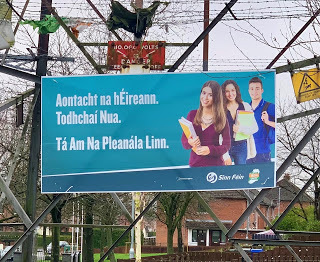
Billboards for Unity
If you have been driving or walking around Belfast, Derry and parts of Dublin and other locations around the country in the last week you will have seen some new billboards and posters proclaiming ‘A New Ireland – A Time to Plan.’ In Belfast the billboards have been erected at some of the city’s busiest junctions and video messages spelling out the advantages of Irish Unity have been posted on social media. Well done to all involved.
The Billboards point to EU membership; Jobs; Prosperity and an All Island Health Service. Sinn Féin Úachtaran Shinn Féin Mary Lou McDonald put it will at the weekend when she urged citizens to be “part of this planning; to be part of making unification a reality. It is our best plan; it is our best chance; it is our future together.”
December 7, 2020
This weeks blog: A Session With Bobby Sands and Solidarity with the Palestinian People
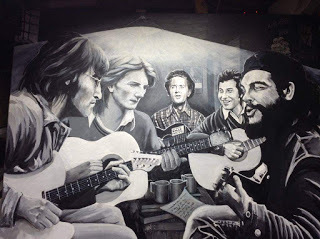 A Session With Bobby Sands.
A Session With Bobby Sands. At last! Danny Devenny is doing a book. He will have to finish it now that this column has broken the story. It will be a photographic and literary journey through his very eventful life. In my opinion Danny Dee deserves a book or twenty books to celebrate his life in struggle and his art.He has enriched all our lives with his creativity and brightened Belfast’s streetscape and educated and uplifted its citizens and visitors with his murals. He will tell how art has been a huge help to him through all his decades of activism. That’s where this painting THE SESSION comes in.
THE SESSION features John Lennon, Danny’s friend Bobby Sands, Ché Guevara, Chilean activist song writer and poet Víctor Jara and Woody Guthrie the great American song writer and activist. It is available as a limited edition print and a not-for-profit funder for Danny’s book. Check out his Facebook page and private message Danny if you want to buy a copy.
Danny has had a mind to do such a painting for a long time. He was in Long Kesh with Bobby and knows how much music meant to him. Bobby loved John Lennon. He would love being in a session with him. And the others. He admired them all. There is a photo of a session of poítín drinking prisoners in Cage Eleven which Danny based his painting on. I will tell you the story of that photo and that session another time.
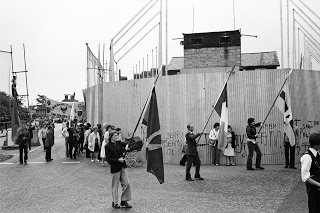 Anyway Danny delayed doing that painting because he couldn't do a side view of Bobby’s face which satisfied him. Then Richard McAuley found the photo of Bobby in French photographer Gerard Harlay’s portfolio of photos when we were doing work on the Léargas book on Máire Drumm. That, and the pandemic, allowed the space for Danny Dee to work his magic.
Anyway Danny delayed doing that painting because he couldn't do a side view of Bobby’s face which satisfied him. Then Richard McAuley found the photo of Bobby in French photographer Gerard Harlay’s portfolio of photos when we were doing work on the Léargas book on Máire Drumm. That, and the pandemic, allowed the space for Danny Dee to work his magic.
I know the political value of that magic from my time in the Kesh with him in the mid 70’s. Danny Dee did the art work for a number of publications produced in Cage Eleven and smuggled outside. These included Peace In Ireland and Our British Problem – unpublished- by this columnist and In Care Of Her Majesty’s Prisons by Hugh Feeney and Prison Struggle. He also did illustrations for the Brownie articles which were smuggled out to the Sinn Féin paper Republican News. His pen name was Flossie.
Danny and Bobby were in the Gaeltacht hut in Cage Eleven. Bobby used to drive his comrades mad as he practised his guitar skills and learned his songs. Tomboy Loudon was just as bad. He was learning the mandolin. Bobby was taught guitar by blues legend Rab McCullough. They started in the Crum (Crumlin Road Prison) where there were two guitars. Bobby heard Rab playing and asked him for a few tips. Rab was already an accomplished guitarist. He had been in a number of bands,including Sunshine and The Big Soul Band.
When Tomboy and Bobby were moved to Long Kesh Rab –an exponent of Robert Johnson’s Delta Blues style–showed Bobby more tricks of the trade. He recalls Bobby was a big Rod Stewart and The Facesfan. He and Tomboy favoured Mandolin Wind.
They also picked up on Christy Moore. Ewen McColl’s fine ballad ‘Tim Evans’ was one of Bobbys first songs. Christy’s renditions led him to Woody Guthrie. James Taylor, Neil Young, Dylan, Bowie, Loudan Wainright 111, Leonard Cohen all influenced him. He used the melody of Gordon Lightfoots ‘The Wreck of The Edmund Fitzgerald’ years later in the H Blocks for ‘Back Home in Derry.’
He loved The Beatles. Especially John Lennon and Paul McCartney because of their songs on Ireland. When Lennon was threatened with deportation from New York, Bobby was among the prisoners who signed a petition in Cage 8 to support him. When McCartney formed Wings Bobby rehearsed ‘Mamunia’ until his hutmates dispaired. They threw oranges and apples at him another time, according to Paddy Donnelly, as he struggled before eventually getting the key change in Lennon’s Imagine. I recall him learning Kris Kristofferson’s ‘Bobby Magee’ in the study hut, just the two of us there, as I whiled away my time planning my next unsuccesful escape.
For their first Christmas in Long Kesh, in Cage 17, Tomboy, Rab and Bobby played at the Cage Concert. By the time they arrived in Cage 11 both Bobby and Tomboy had a reasonable collection of songs. When Coireall MacCurtain arrived in from Limerick and started Irish ranganna his teaching regime included A Singing Rang. Bobby, by now a committed Gaeilgeoir, learned ‘Gleanntáin Ghlas' Ghaoth Dobhair’ and ‘Báidín Fheilimí’. He later went on to write his own songs í nGaeilge. There was only one Record Player in the Cage. Each hut got a go at it. Bobby played Prosperous non-stop and Clannad, Band On The Run and Bowie. By now his brother Seán had sent him in a guitar and song books. I remember him playing and singing at our Cage concert the Christmas before he was released. Tomboy got out later and Bobby played at his homecoming gig in Unity Flats. He then suggested to Tomboy that they form a group. They did. Pheonix was their name. They had only two gigs. In the LESA (League of Ex-Servicemen’s Association) and Saint Matthew’s clubs. Then Bobby was re-arrested and Tomboy was back on the run. Before then they had one good night down in Omeath. Tomboy recalls they ended up at a local wedding. A showband, The Four Aces was playing and most of the older wedding guests were walzing serenely as Bobby, his wife Geraldine and Tomboy watched. When Bobby went off to the Gents Tomboy put his name down for a song request. He was duly called and on borrowing a guitar from one of The Four Aces Bobby launched into ‘Pinball Wizard’ by The Who. Tomboy says none of the walzers applauded at the end. Suitably mortified Bobby told Tomboy with a big grin that it was like he was back singing in the Kesh.All of this was before the horrrors of the H Blocks. So is the photo which Danny Dee used for The Session. He told me he wanted to show Bobby as he was. ’A light hearted funny guy’.
Thank you Danny Dee. May your murals keep our heads high. Go raibh maith agat Bobby Sands. Let your music keep our spirits high.
Solidarity with the Palestinian People
A few weeks ago this column wrote about the hunger strike of Palestinian prisoner Maher al-Akhras. He was on hunger strike for a remarkable 104 days against his internment by Israeli authorities under their infamous ‘administrative detention’ system. Maher ended his hunger strike on the 6 Novemer following a commitment that he would be released on 26 November and not served with a further detention order.
Two weeks ago he won his freedom and was taken to the Najah hospital in Nablus in the occupied west Bank. Maher’s courageous stand against the shameful system of administrative detention successfully brought the use of this repressive legislation to a wider international audience. It is also a reminder of the denial of sovereignty to the Palestinian people; the ongoing occupation of Palestinian land by Israel; and the apartheid system which most Palestinian’s are forced to live under.
Two Sunday's ago was the ‘International Day of Solidarity with the Palestinian People’. This annual act of solidarity with the Palestinian people was agreed by the United Nations General Assembly in 1977 (resolution 32/40 B). It takes place on 29 November each year in remembrance of the resolution passed on that day by the UN which partitioned Palestine (resolution 181 (II)).
The partition of Palestine has created over 80 years of conflict and instability in that region. The human rights consequences for the Palestinian people have been horrendous. The Palestinian people are regularly denied freedom of movement; access to jobs, goods and services, including fuel and food and in the midst of a pandemic, healthcare.
Three weeks ago in an act symbolic of the conditions endured by the people of Palestine, 73 people, including 41 children, were forcibly removed from their homes in the village of Khirbet Humsa and watched as Israeli military excavators smashed them into the ground. The Israeli forces also destroyed 30 tones of food for animals and confiscated two tractors.
It was according to the United Nations the largest forced displacement incident in four years. Yvonne Helle the United Nations coordinator for the occupied Palestinian territory said: “Demolitions are a key means of creating an environment designed to coerce Palestinians to leave their homes.” So far this year almost 700 structures have been demolished in East Jerusalem and the west Bank.
However this Israeli tactic goes beyond demolishing Palestinian homes. For years it has destroyed EU funded infrastructure projects in Palestine. Last year 127 structures, mostly funded by EU member states, were destroyed in Israeli authorities. In September 2019 EU member states spoke out against the Israeli policy of demolition. At the time they reported that “the period from March to August 2020 saw the highest average destruction rate in four years."
At the same time the EU, which purports to support a two state solution, is Israel’s number one trade partner. It also sells significant amounts of weapons to Israel.
The effect of this contradictory, confusing and ineffective stance by the international community allows the Israeli government to ignore protests and the demands of the United Nations for Israel to accept the rights of the people of Palestine.
The diplomatic and political policy of successive Irish governments in respect of the Palestinian people has failed. It’s time for a new strategy. In 2014 the Oireachtas voted in support of the Irish government officially recognising the state of Palestine and providing official Embassy status to the Palestinian Mission in Dublin. It’s long overdue that this was done. The FF/FG/GP government should also end their opposition to the Occupied Territories Bill – which would ban imports from illegal Israeli settlements in Palestinian territories. They should bring it back before the Oireachtas as soon as possible.
November 30, 2020
This weeks Blog deals with 'Economic Self-government; Covid-19 and the Conspiracy business; and The Speaker, King Billy , the Pope and the painting
Economic Self-government is the future.
Last Friday, as this column noted, Sinn Féin published a new discussion paper – The Economic Benefits of a United Ireland.
At the heart of the paper is a belief in economic self-government. The right and the ability of the people of Ireland to plan, manage, and develop our island economy in our best interests. It makes sense. Whatever differences may exist between the political parties on this island it is clear that they would prioritise economic policy in the interests of those they represent.
On the other hand British government’s rule in British interests and take political and economic decisions that suit their objectives and not those of the people of the North and of this island.
The ‘Economic Benefits of a United Ireland’ confronts the first question usually posed by those who are opposed to Irish Unity or those who are uncertain of that goal; ‘can we afford a United Ireland?’
The answer is yes. As Pearse Doherty TD remarked at the launch; “The health of an economy, the standard of living of its citizens; is driven by investment, research, innovation, good public services and access to the global economy. On all of these, not only is the Union stuttering, it is moving backwards...
The North deserves better, and a United Ireland offers so much more. Irish unity would allow for coordinated investment and development; something the Border region has been missing for a century. Irish unity would utilise economies of scale; allowing one economy to develop rather than having two economies compete. The current trajectory of the all-island economy attests to these opportunities”.
The reality is that the Northern Executive doesn’t have access to any significant financial levers except rates. 90% of the Executive’s budget is directly controlled by London. The Assembly cannot devise long term fiscal policy or plan for the longer term. This is dictated by the British Government.
But what of the so called British subventions? British official stats put the subvention at around £10 billion per annum. In reality, the true value is somewhere between £2.5 and £6 billion. The economic payoff from uniting the two economies on the island would more than compensate for the loss of the subvention. Economists such as Kurt Hubner and David McWilliams agree.
As Pearse Doherty attests “Reducing the argument to the subvention is an own goal, the subvention only exists because the economy in the north is so underdeveloped, the subvention is a measure of the failure of BG financial policy in the north.”
With almost seven million people and a larger economy, Irish Unity will create better jobs, increase incomes, improve our quality of life and deliver better public services. The discussion paper considers the advantages of Unity for the promotion of the Green Economy; the precedent of German re-unification; and the role the EU can play in successfully reuniting Ireland.
If you want to find out more go to : www.sinnfein.ie. Be part of the discussion.
Covid 19 and the conspiracy business
There is hope on the horizon that a vaccine may soon be available for the Covid-19 virus. This is a very welcome development but until it is available and distributed it is vitally important that citizens stick to the consistent advice that the health authorities have been giving since the start of the year.
Wear a mask; socially distance; wash your hands; and use a hand sanitiser.
The changing conditions have meant that the regulations, restrictions and lockdown processes are constantly changing. This has led to confusion, annoyance and anger. In our own place this has been added to by the refusal of some DUP ministers to play a consistent and constructive role alongside their colleagues on the Executive.
The reality is that the Coronavirus is an unparalleled event in our lives. At the time of writing almost one and a half million have died across the world. In the North almost a thousand people will have died by the end of this week and in the South over two thousand have died. Thousands more have been hospitalised or been taken ill with this virus.
This Friday the North begins a two week lockdown. The restrictions willcreate hardship. But if lives are to be saved then it is necessary for us to follow the health advice.
One deeply worrying feature of recent months has been the growth in conspiracy theories around Covid-a9. Some say that Covid doesn’t exist; that wearing a mask is dangerous; that the Coronavirus is part of some grand plan by a cabal of leading states and politicians to control the world economy and limit peoples’ rights; and/or is a plot by big pharma to make money. In addition Covid deniers claim that the number of people dying from Coronavirus is being deliberately exaggerated by governments. And there is the claim that the extension of 5G technology is to blame for the spread of the disease.
Lies; misrepresentation of facts; and right wing fantasy propaganda have become part of the daily diet of millions on social media.
One dangerous consequence of this is that increasing numbers of people are not just saying they will refuse to take a vaccine to immunise against Covid when it becomes available but are questioning the efficacy of vaccines in their entirety. A survey of 26,000 people in 25 countries last month by the YouGov-Cambridge Globalism Project in collaboration with the London Guardian found “widespread and concerning scepticism about vaccine safety.”
It reported that 20% of respondents across 19 countries gave some credibility to the view that “the truth about the harmful effects of vaccines is being deliberately hidden from the public”, including 57% of South Africans, 48% of Turks, 38% of French people, 33% of Americans, 31% of Germans and 26% of Swedes.
According to the World Health Organisation; “Vaccines have been one of the biggest success stories of modern medicine. WHO estimates that at least 10 million deaths were prevented between 2010 and 2015 thanks to vaccinations delivered around the world. Many millions more lives were protected from the suffering and disability associated with diseases such as pneumonia, diarrhea, whooping cough, measles, and polio.”
So, in these dangerous times ignore the naysayers and sceptics, and the conspiracy theorists. Follow the health advice.
The Speaker, King Billy, the Pope and the painting
Sinn Féin MLA Alex Maskey is the Speaker –An Ceann Chomairle - of the Assembly. In the waiting room of his official office in Parliament Buildings there hangs an unusual painting. When it was bought in 1933 by the Unionist government to adorn the wall of their new Parliament Building it was claimed to be a work by Pieter van derMuelen. He was allegedly a court painter for William of Orange. It is supposed to show a triumphant King William on a white charger landing at Carrickfergus at the start of his successful war with the English King James 11. When it was announced that the painting had been purchased unionist MPs cheered.
In March 1933 the painting was unveiled in the lobby outside the Members’ Room. The applause which had accompanied the news of its successful purchase quickly turned to horror when it was examined.
If you look closely at the painting you will see Pope Innocent X1, resting on a cloud above King Billy, giving a papal blessing to the King. Leading William and his entourage is a man on foot – apparently a Franciscan friar – with rosary beads in his hands. Pope Innocent X1 who ordered a Te Deum to be sung when news arrived of Williams victory at the Boyne, was an ally of the Prince of Orange in a war then convulsing much of Europe.
A few months after it was unveiled the painting was damaged by Charles Forrester, a member of the Scottish Protestant League who was affronted by it. It was restored but removed from public view. It was placed in the Speakers Office in 1983 where it remains.
There is some speculation that the painting is not a representation of King William at all or of his landing in Ireland but has to do with his war against the French in the Low Countries in Europe.
It is also claimed that van derMuelen was not a court painter for William. It is said that he was a minor painter, and may not have been responsible for the painting at all.
Before the Covid restrictions the painting was a popular part of the tour which the Assembly staff provided for those who visited the building. So, when the tours are eventually reinstated post Covid and if you want to see a painting naively bought by the Unionist government in 1933 which does not show King Billy on his White Charger landing at Carrickfergus but has a more interesting story to tell, why not visit Parliament Buildings for a wee juke.
The painting on the Wall in the Speaker's office
November 23, 2020
This weeks blog examines the Economic Benefits of a United Ireland; Remembers Danny Groves; and Decision awaited in Pat Finucane case
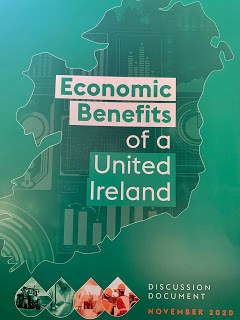
Economic Benefits of a United Ireland
In four weeks (23 December) we will mark 100 years since the Government of Ireland Act, which partitioned Ireland, was signed into law by an English King. Six years earlier James Connolly, writing in the Irish Worker in March 1914, warned that partition “would mean a carnival of reaction both North and South, would set back the wheels of progress, would destroy the oncoming unity of the Irish labour movement and paralyse all advanced movements whilst it endured. To it Labour should give the bitterest opposition ...”
The northern state that emerged following partition delivered all that Connolly feared. Political Unionism and its business class built an apartheid ‘Orange’ state on sectarian divisions. They turned worker against worker and introduced a system of structured political and economic discrimination which continues to impact on northern society today.
Partition also inflicted great hurt on the southern economy. Places like Sligo and Monaghan and Derry, Dundalk and Newry were separated from their natural economic hinterland by an artificial border. Along the 300 miles of border farmers were cut off from their land; neighbours from neighbours; families from their relatives, and businesses from their customers.
Two conservative states, with two conservative elites, were established that took economic decisions that left the border region impoverished and a section of citizens in the North as second class citizens. We have had 100 years of disjointed and competing economic and social development on this small island.
In recent years, most notably since the Brexit vote of 2016, there has been a growing debate on the merits of Irish Unity. Much of that has focused on the issue of the economy.
This week Sinn Fein is publishing a new paper: the ‘Economic Benefits of a United Ireland’ which examines the failure of partition and sets out the economic benefits that will accrue from a single island economy in a United Ireland.
The paper reveals that the North is the slowest growing economy on these islands. The labour market is characterised by jobs that are lower paid and less secure than in the Irish state or in Britain. Some 20% of workers earn less than a basic living wage. In addition the wasteful competition and division rising from partition undermines the fortunes of both sides of the border region. The result is an incoherent and unfulfilled economic development.
The ‘Economic Benefits of a United Ireland’ also refutes the claim that the Irish state cannot afford Irish Unity or cope with the loss of the British subvention. The claim that the subvention is worth £10bn a year is false. The real figure is at most £6bn and closer to less than half that.
The threat posed by Brexit and Covid-19 have also created new challenges and new opportunities. A United Ireland offers the best opportunity to tackle these issues in a way that is to the economic advantage of the people of the island of Ireland.
The ‘Economic Benefits of a United Ireland’ is an exciting contribution to the conversation about a new Ireland – a shared Ireland. It reveals an island economy capable of expanding its economic potential, creating new jobs, better paid jobs, building a better standard of living of all its citizens and first class public services, including a health service for everyone.
We should have the right to organise our own economy. We will certainly do that much better than anyone in London.
Danny and Jim O'Carroll
The death of Danny Groves
It is the nature of things that this column has been moved to record the deaths of friends more often than I would like to but it is with the greatest sadness that I extend my condolences to the family of Danny Groves who died last Sunday. Danny died after a long battle with cancer. I want to express my sympathies to his wife Liz, and to his children Roisin, Bill, Jim, Eilis, Danny, Emma and Deirdre and to his many grandchildren, great grandchildren and extended family circle.
I have known Danny and Liz for more years than I care to remember. The Groves family is one of those spinal republican families that have been involved in republican activism from the time of partition.
Danny was a member of the Tom Williams Pipe Band in the 1960s and participated in countless commemorations, Easter Parades and fund raisers for Sinn Féin and the National Graves Association. Joe Cahill was the President of the Band. Danny marched for civil rights in 1968/69 and in the pogroms of 1969 he was one of those who helped evacuate families out of Ardoyne into the west of the City.
Both Danny and Liz are from North Belfast. They moved to a flat in Lenadoon after they were married in July 1970 and then in 1972 moved again to Tullymore Gardens in upper Andersonstown. They lived three doors up from Danny’s mother, the indomitable Emma Groves. In December 1971 Emma, who was the mother of 11 children, was blinded by a British soldier who fired a rubber bullet at her through the window of her home. It was a devastating injury. Emma refused to allow her injury and disability to define her. Along with Clara Reilly she formed the United Campaign Against Plastic Bullets and with the support of Danny and her large family she campaigned tirelessly against the use of rubber and plastic bullets.
From those early years in the 1970s Danny and Liz have been part of the backbone of the Sinn Fein organisation in the Upper Andersonstown area. Despite having a large family there was always a ready welcome in their home for republican activists. Frequent house raids, harassment, constant arrests and threats by the British Army and RUC were a regular feature of Danny’s life at that time. He and Liz refused to be intimidated.
No job was too big or too small for Danny, especially during elections. You needed someone brought to a polling station his car was available. You needed someone to deliver leaflets or stand outside a polling station in the freezing cold and rain? Danny was your man.
Liz is one of the best known community workers in Belfast. She has been a key advice centre worker for Sinn Féin in Connolly House for many years and despite the Covid-19 pandemic Liz continues to work and use her experience on behalf of constituents.
During his illness Danny retained his strong sense of humour and although confined to his bed kept abreast of political developments locally as well as internationally. Danny was also more than willing to help where possible. Recently, Richard McAuley who is involved in doing some background research for a Léargas book I am writing on Kathleen Largey/Thompson, contacted Liz and asked if he could talk to her and Danny about Kathleen. Both knew Kathleen and Eamonn Largey. While maintaining social distance Richard visited Danny and Liz. Danny’s memory was undiminished by the years or his illness. He and Liz were very helpful. Lots of craic about An Ard Scoil, the 43 Club and the old Felons at Milltown.
Danny will be missed. By Liz and his children and the Groves family. But also by his neighbours and many friends whose lives he touched and enriched over the years. Ar dheis Dé go raibh a anam dílis
Awaiting a Decision in Pat Finucane Case
The courage and tenacity of the Finucane family after years of battling with the British state continues to amaze and inspire. Pat Finucane was killed in February 1989 by a UDA death squad working in collusion with RUC Special Branch, the British Army’s Force Reconnaissance Unit and the British state,. For three decades the family, like many hundreds of others, have been fighting to get to the truth. Successive British governments have blustered and bluffed, stalled and lied in order to prevent this.
Last month a lawyer acting for the British Secretary of State for the North Brandon Lewis gave the High Court in Belfast a commitment from him that a decision would be taken on whether to proceed with a public inquiry on or before the 30 November. That’s next week.
Geraldine Finucane brought a judicial review against the British Secretary of State for his failure to implement last year’s Supreme Court ruling which criticised the British government’s failure to take a decision on establishing an investigation. On 11 October the barrister acting for Brandon Lewis told the court that he had been instructed to offer a commitment that a decision would be taken on or before 30 November.
The Judge adjourned the case until December. We now await the decision of the British Secretary of State.
Regrettably, the years of prevarication and disinformation around Pat’s case is part of a wider conspiracy by the British state to refuse to hold its security and intelligence agencies t account for their actions during the conflict. The decision by the PPS in relation to the Operation Kenova Case and the refusal to implement the Stormont House Agreement reached in 2014 are all evidence of this.
The decision by Brandon Lewis in respect of Pat Finucane will indicate whether it’s business as usual for this British government or if it is finally prepared to face up to its legal and international human rights obligations.
November 16, 2020
Make Voting Easier; Polls telling a vital story and Do you have an old An Phoblacht
Make Voting Easier
Joe Biden is now the President Elect of the USA. Kamala Harris – the first woman to hold thís post – will be the new Vice President.
There is always huge interest in Ireland about USPresidential elections. The well known family connection between Joe Biden and Ireland has reinforced this interest. Kamala Harris also has Irish roots as well as Tamil Indian and Jamaican family connections. Her mother is from India, her father from Jamaica. By coincidence both the President Elect and the Vice President Elect share the same familyname. Joe Biden is the great grandson of Owen Finnegan from the Cooley peninsula in County Louth. Kamala Harris’ Jamaican greatgrandmother’s first husband was Patrick A Finegan, the mixedrace son of an Irishman of the same name.
Their story is the story of Ireland’s diaspora and our globalconnections. Their familyhistory must be a fascinatingtale. The next phase of it will be even more interesting. Therewill be high expectations of the incoming Vice President not least among women and black American women in particular.
Both Joe Biden and Kamala Harris have huge challenges before them and I wish them well. I know President Biden. The Irish and British establishments willbe watching him closely. I’m sure British representatives will soon be wingingtheir way to DC. But I’m also sure that Ireland’s friends in the Capitol will be wise to that and I’m confident they and Joe Biden will stand over their commitment to defend the Good Friday Agreement.
One aspect of the US election campaign that we in Ireland should scrutinise more closely is the effort put in by most states and electoral bodies to make voting in the election as easy as possible.
Over 100 million citizens voted by mail or in person in early voting. Millions stood in long lines for hours in the weeks leading up to election day on 3 November. The demand was so great that drive through voting booths were established in some areas.
In 2016 47 million US citizens voted early. This time that figure was smashed ten days before polling day. The Covid-19 pandemic clearly played a part in persuading people to vote early and by mail but the fact that voting was made easier encouraged more citizens to participate in the democratic system.
Of course, there were efforts to suppress the vote in some states but despite this the American electorate chose to embrace all of the democratic methods available to them to vote in historic numbers.
This is a lesson that the two electoral systems on this island should examine closely. Despite claims in the past of voter fraud there has been no evidence of organised voter fraud over recent decades. What we do know, certainly in the North, is that every year many voters find that for no reason they have been taken off the register.
Elections are about citizens choosing who should have responsibility for managing the political system, making law and taking the economic, health, social and environmental decisions that will impact on their lives and their futures.
If a country as vast as the USA with 250 million voters can facilitate and encourage massive postal voting and in-person voting weeks in advance why can’t we?
If a country as diverse as the USA and with 50 states with different electoral rules and regulations can allow for in-person voting weeks before polling day. Why can’t we?
The island of Ireland has a population that is less than that of the state of Massachusetts. If the USA can make voting easy for its citizens why can’t we?
A voting system that makes voting easy – that encourages citizens to participate - while enforcing rules and regulations to prevent fraud must be a positive to any democratic system. More people voting is good for democracy and good for holding parties and governments to account. It will also be essential for a fair outcome to the referendum on Irish unity when that day comes.
Polls telling a vital story
There is a fixation with political opinion polls. I have a healthy scepticism of such polls. I know from long experience that they rarely reflect the Sinn Féin vote and there have been examples internationally, including last week’s US election, where the final election result was significantly different to that predicted in the polls.
Opinion polls have been around for many decades and use different methodologies. As well as evidencing the shifting political allegiances of voters in the North opinion polls and electoral results have underlined the growing demographic changes that are increasingly evident.
No month passes without some new survey being published. It is then scrutinised and parsed from every conceivable angle by political correspondents, academics, editorial writers and bloggers who seek to read the public mood and identify possible political trends.
Opinion polls have also focused on the related issues of Irish Unity and a referendum on Irish Unity. In May 2019, during the European and local government elections in the South, an opinion poll conducted at polling stations for RTE recorded 65% of respondents saying they would vote yes for a united Ireland if it were held the following day.
This has been a pattern in recent years. A LucidTalk poll two weeks ago reported that 43% of 18-24 year olds in the North would definitely vote to end the union with Britain. The poll claimed that 34% would support remaining. Among those aged between 25-44 LucidTalk said that 42% strongly favour a United Ireland.
The public mood as revealed in polls is also reflected in recent election results which have seen political unionism lose its electoral majority. It’s all a long way from the imposition of the Government of Ireland Act 100 years ago next month. Change is clearly taking place.
Change too is taking place in Scotland where an opinion poll last week for Politico said that independence for Scotland now has a 12 point lead. This is the 11th poll in a row which has claimed that there is majority support for independence.
The Scottish National Party is busy planning for a referendum on independence and is honing its arguments. According to the US based Bloomberg News the British government is also planning to win public support in Scotland for retaining the Union.
So, the Scottish Government is planning for Independence. The British government is planning to challenge the independence campaign. Yet, faced with many of the same challenges and a growing public conversation around a referendum on Irish Unity An Taoiseach Micheál Martin and the Irish government have chosen to prevaricate, obfuscate, distract and do everything possible to avoid planning for a referendum or for a United Ireland. Failing to plan is no plan.
Do you have an old An Phoblacht?
The republican paper An Phoblacht- now a quarterlymagazine - needs your help. Thís year it celebrates 50 years of unbrokenpublication. As someone who writes regularly about recentrepublican history An Phoblacht and An Phoblacht/Republican News is a great resource.
However, over the years editions of the paper were lost. That means we no longer have a complete archive. So, we are looking for your help in completing our archive.
We need specific issues of An Phoblacht/Republican News ranging from 1979-2015. If you or somebody you know has an issue of An Phoblacht from this period and want to help us, drop an email to admin@sinnfein.ie or call Ph: 01 872 6100. We look forward to hearing from you.
Gerry Adams's Blog
- Gerry Adams's profile
- 29 followers


